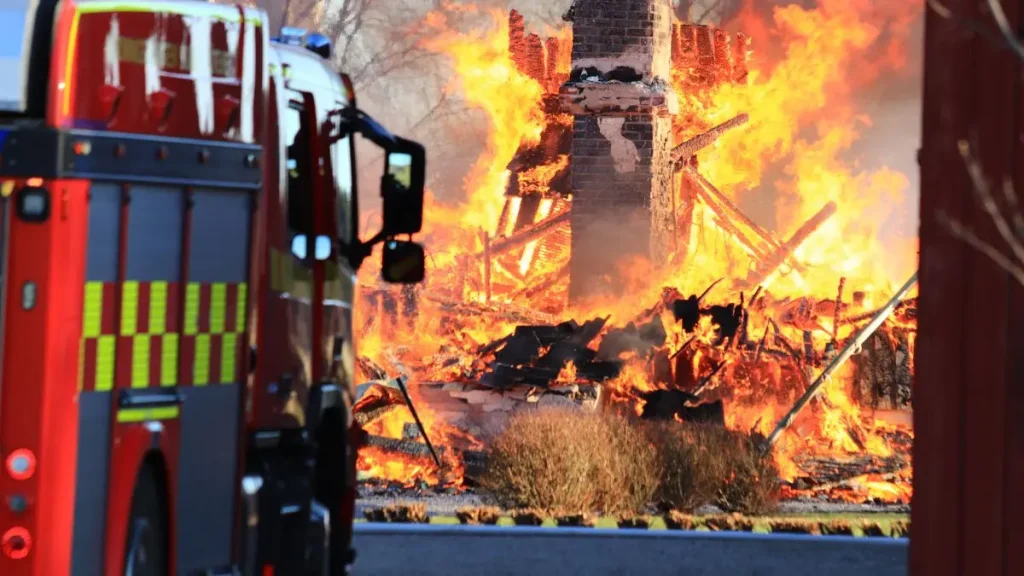Oregon Firefighters Save Dog While Fighting Intense Home Fire
When I first heard about the fire in Sweet Home on Monday morning, my mind went straight to the people inside. Then I learned there was a dog — a 14-year-old Pomeranian named Tucker — trapped in the burning home. If you’ve ever had a pet, you know they’re not “just animals.” They’re family.
The blaze started around 8:30 a.m. at a house on Highway 228. By the time crews arrived, the garage and home were already engulfed. Multiple 911 calls had poured in, and the first firefighters knew they were walking into a fight. The location made things worse — no fire hydrant nearby meant water had to be hauled in with tenders, slowing everything down when every second mattered.
Still, they went in. Through thick smoke, collapsing debris, and searing heat, the team pushed forward with a primary search. And then — relief. They found Tucker, frightened but alive. That single moment is why firefighters take these risks: because sometimes, saving one small life changes everything for a family.
Fires like this remind me how unpredictable life can be. One minute it’s a normal morning, the next you’re counting on strangers in turnout gear to save everything that matters. And in this case, they did.
If your home is in a rural area, do you have a plan for your pets if a fire breaks out?
The Rescue of a 14-Year-Old Pomeranian
I can’t stop picturing the moment they pulled Tucker out. According to KPIC, firefighters were doing their primary search when they spotted the little Pomeranian. Fourteen years old, smoke all around him, probably terrified and disoriented.
If you’ve ever been in a high-stress moment with your pet, you know how time slows down. The crews didn’t just grab him and run — they had to keep him calm while getting him out quickly and safely. This wasn’t a side mission; it was part of their core job that morning.
And here’s the thing: most pets don’t survive house fires, especially when smoke fills a home this fast. Tucker’s rescue was more than luck — it was training, speed, and the refusal to give up. If you and I want our pets to have the same chance, we need to plan for them in our own emergency checklists.
Just earlier this year, a similar lack of hydrants complicated efforts in an Alaska home fire that left one person dead and another hurt — a reminder of how location can shape the outcome.
Challenges Firefighters Faced in a Rural, Unhydranted Area

Here’s where the reality of rural living hits hard. KEZI reported that there was no hydrant anywhere near the home. That meant crews had to shuttle water using tenders — basically trucks that carry thousands of gallons each trip.
Imagine fighting a fire while waiting for your next water delivery. It’s not like in the movies where there’s a hose spraying nonstop from the street. Every refill takes time, and that time gives the fire more room to destroy.
And then there’s the structural danger. The home’s integrity deteriorated fast, forcing crews to switch to a defensive attack — which means staying outside and fighting from a safer distance. For you and me, that’s a reminder: the further we are from fire services and hydrants, the more we need to take prevention into our own hands.
Fires in rural areas often unfold differently, and staying informed can make all the difference. I’ve been sharing real-time safety alerts and rescue updates on a WhatsApp channel — if you want those straight to your phone, you can join here.
Safety Lessons for Rural Homeowners
Let’s be honest — most of us don’t think about hydrants until we need one. If you live in an area without one, like this Sweet Home neighborhood, your safety net is smaller. That means it’s on you to build your own layers of protection.
Have you walked your property with a firefighter or safety inspector? They can point out hazards you might miss. Do you have a pond, pool, or other water source crews could tap into if needed? Is your driveway wide and clear enough for a tender to turn around?
And don’t forget your pets. Keep carriers near exits, train them to come when called, and make sure they have ID tags or microchips. In an emergency, you won’t have time to think — you’ll only have time to act.
What’s the one thing you’ve done to make your home safer from fire? Share it in the comments — your tip might help someone else prepare.
The Bigger Picture: Pet Rescues in Fires
Pet rescues in fires aren’t rare, but they’re far from guaranteed. Nationally, tens of thousands of pets die in house fires every year, often from smoke inhalation long before flames reach them.
Firefighters are trained to look for signs of pets during their searches, but there’s no magic — it comes down to conditions, access, and time.
Some departments now carry pet oxygen masks, and if your local station doesn’t, you can actually donate one.
Small steps like that can tip the odds in an animal’s favor. If you love your pets as much as I love mine, think about how your own home’s fire readiness would stack up if crews had to find and save them.
In one tragic case, a Streamwood house fire claimed two lives and left another person critically injured — proof that even suburban areas aren’t immune to fast-moving fires.
What’s Next in the Investigation?

Right now, the cause of the fire is still under investigation. That’s not unusual — figuring out exactly where and how a fire starts can take days or even weeks. Investigators will be looking for burn patterns, electrical points, and anything that could indicate whether it was accidental or something else.
For you and me, this is the part we usually skip over in the news. But here’s the truth: understanding the cause isn’t just about closure for the family — it’s about prevention for everyone else. If the fire came from faulty wiring, for example, that’s a wake-up call to check our own homes.
If it was something as simple as a misplaced space heater, it’s a reminder that small habits can carry big risks.
Not every story ends like Tucker’s; in Deerfield, a house fire claimed the life of a woman before crews could reach her.
Final Thought: A Tale of Bravery, Teamwork, and Hope
I keep thinking about Tucker — a small dog pulled from a house that was moments away from collapse. The image says everything you need to know about why firefighters do what they do. It’s not just about saving property; it’s about saving lives, big and small.
We can’t control when disaster strikes, but we can control how ready we are. That means having a plan, knowing our risks, and making sure our pets are part of that plan.
So here’s my question for you: if a fire started in your home tomorrow, would you and your pets be ready to get out — and fast?
Want to read more real-life stories and safety insights? Explore our full coverage on home fire incidents for lessons you can apply today.
Disclaimer: The information in this article is based on publicly available reports and official statements. Details may change as the investigation continues. Always follow guidance from local fire authorities for safety and prevention.


